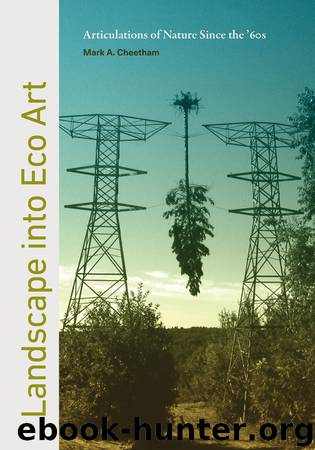Landscape Into Eco Art by Cheetham Mark A

Author:Cheetham, Mark A.
Language: eng
Format: epub
Publisher: Pennsylvania State University Press
are its various temporal aspects: the creation of the garden, the cycle of changing seasons, but also the visitors’ physical moving-through its convoluted and intricately linked spaces. What I find so inspiring is that these different notions of time passing are taken as explicit co-producers of the garden.
When I went into the scholar’s garden, I saw the garden, but I also saw the limits of what I could see; I saw the construction of my own way of seeing things.20
Over the short duration of the video, Koerner choreographs both his physical union with the natural forms we see and the garden’s artificiality, what we might call its technologies of emplacement. He bends to conform to the shape of a branch, for example, becoming nature. Yet his complex arm and hand movements do not seem natural from any angle. Especially successful in conveying this double sense of participation at a distance, seeing oneself seeing, as Eliasson describes other work, are images reflecting both the dancer and the garden’s architecture in a mirror, a device he often uses, notably on the ceiling of Tate Modern in The weather project. At times the mirror itself is visible in Your embodied garden; at others we see only what it reflects, the dancer or one of the garden’s portals. The mirror brings space to the video camera, but that space is prearranged by the norms of Southern Song Dynasty garden design. The soundtrack conveys both birds chirping and passing traffic, elements not necessarily in the garden physically, except for their sounds. We catch glimpses of others viewing the garden and Koerner’s dance performance too, though the sense of the constructed and cultivated nature of this space comes across most in shots of the dancing in which we also see two gardeners pruning a tree. His moves match the gardeners’ articulation of nature spatially and temporally, as the strictly regimented garden itself does, dispelling the cultural pollution, the deleterious attitudes that Serres rails against.
Vatnasafn / Library of Water (2007; see fig. 2) also polled local residents’ views on the weather and archived these testimonials and the all-important “weather words” on the floor and in the reading room of the indoor space. This work can also be understood to react to Serres’s emphases on data, the inside/outside disconnection, the suspension of time’s long duration, and the tainted attitude our culture has toward climate change and the weather. I have mentioned that Horn’s physical modification of the former library included enlarging the windows to let the weather seem even more proximate at a site that is on a high point in the village and looks out to the ocean. Like all coastal fishing communities, Stykkishólmur is intimately involved with the weather and with rising sea levels. While we may read in Horn’s repurposed library, we do not read words in isolation from the material traces of glaciers, which, as we have seen, can themselves behave linguistically in her installation. The experience of walking through the more sculptural elements
Download
This site does not store any files on its server. We only index and link to content provided by other sites. Please contact the content providers to delete copyright contents if any and email us, we'll remove relevant links or contents immediately.
Ways of Seeing by John Berger(1293)
The Perfumes The A-Z Guide by Luca Turin(1099)
Rembrandt Drawings by Rembrandt(1088)
The Hare with Amber Eyes by Edmund de Waal(1077)
It's Never Too Late to Begin Again by Julia Cameron(981)
On Photography by Walter Benjamin(928)
Natasha's Dance by Orlando Figes(897)
A Month in Siena by Hisham Matar(866)
Why Architecture Matters by Paul Goldberger(826)
Minor Feelings by Cathy Park Hong(817)
The Sound of Paper by Julia Cameron(815)
0062259628 by Sarah Strohmeyer(814)
The Selected Poetry of Rainer Maria Rilke by Rainer Maria Rilke(814)
0544325265 by Brendan Jones(800)
Citizen: An American Lyric by Claudia Rankine(782)
Proust Was a Neuroscientist by Jonah Lehrer(768)
The Death of the Artist by William Deresiewicz(753)
Perfumes the Guide 2018 by Luca Turin(752)
And Our Faces, My Heart, Brief As Photos by John Berger(725)
